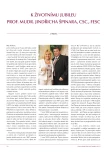Transcranial colour-coded duplex sonography to evaluate intracranial arteries in patients with cerebrovascular stenooclusive disease – review
Authors:
J. Žižka
Authors‘ workplace:
I. interní klinika, Fakultní Thomayerova nemocnice, Praha
Published in:
Kardiol Rev Int Med 2010, 12(2): 88-93
Overview
Transcranial colour-coded duplex sonography is a relatively new imaging technique that allows examining, through an intact scull, of the morphology and haemodynamic situation within the intracranial circulation as well as it allows depiction of other, extra-vascular, intracranial structures. Compared to the earlier introduced transcranial dopplerometry, this technique allows direct imaging of the examined structures and amending of the insonation angle during vascular flow measurement, thus enabling measurement of the real flow speed. This is a non-invasive, relatively inexpensive and easy to repeat technique that may be performed at the patient’s bed. Poor quality of acoustic window in some patients is the main disadvantage that precludes proper assessment in 20% of patients. This drawback might to some extent be eliminated when an ultrasound contrast agent is used and thus, in total, considering potential use of echo-contrast, more than 90% of patients can be examined. This review focuses on the main principles behind this technique and its use in the diagnostics of intracranial artery stenoses and occlusions and its significance for the evaluation of haemodynamic consequences of extracranial artery stenoses or occlusions for cerebral circulation.
Keywords:
sonography – cerebrovascular disease – intracranial stenosis – intracranial occlusion – intracranial collateral pathways
Sources
1. Školoudík D, Václavík D. Transkraniální barevná duplexní sonografie – národní standard vyšetření v rámci funkční specializace v neurosonologii. Čes Slov Neurol Neurochir 2002; Suppl. 2: 18–21.
2. Marinoni M, Ginanneschi A, Forleo P et al. Technical limits in transcranial Doppler recording: Inadequate acoustic windows. Ultrasound Med Biol 1997; 23: 1275–1277.
3. Boespflug O, Chun Feng L. Transcranial pulsed Doppler. Problems posed by the temporal window (834 patients). J Mal Vasc 1992; 17: 112–115.
4. Hocksbergen AW, Legemate DA, Ubbink DT et al. Success rate of transcranial color-coded duplex ultrasonography in visualizing the basal cerebral arteries in vascular patients over 60 years of age. Stroke 1999; 30: 1450–1455.
5. Seidel G, Kaps M, Gerriets T. Potential and limitations of transcranial color-coded sonography in stroke patients. Stroke 1995; 26: 2061–2066.
6. Gomez CR, Brass LM, Tegeler CH et al. The transcranial Doppler standardization project. Phase 1 results. The TCD Study Group, American Society of Neuroimaging. J Neuroimaging 1993; 3: 190–192.
7. Kollár J, Schulte-Altedorneburg G, Sikula J et al. Image quality of the temporal bone window examined by transcranial Doppler sonography and correlation with postmortem computed tomography measurements. Cerebrovasc Dis 2004; 17: 61–65.
8. Baumgartner RW, Baumgartner I, Mattle HP et al. Transcranial color-coded duplex sonography in the evaluation of collteral flow through the circle of Willis. AJNR Am J Neuroradiol 1997; 18: 127–133.
9. Kaps M, Seidl G, Bauer T et al. Imaging of the intracranial vertebrobasilar system using color-coded ultrasound. Stroke 1992; 23: 1577–1582.
10. Martin PJ, Evans DH, Naylor AR. Transcranial color-coded sonography of the basal cerebral circulation. Reference data from 115 volunteers. Stroke 1994; 25: 390–396.
11. Schöning M, Walter J. Evaluation of the vertebrobasilar- posterior system by transcranial color duplex sonography in adults. Stroke 1992; 23: 1280–1286.
12. Baumgartner RW, Arnold M, Gönner F et al. Contrast-anhanced transcranial color-coded duplex sonography in ischemic cerebrovascular disease. Stroke 1997; 28: 2473–2478.
13. Nabavi DG, Droste DW, Kemény V et al. Potential and limitations of echocontrast-enhanced ultrasonography in acute stroke patients: a pilot study. Stroke 1998; 29: 949–954.
14. Baumgartner RW. Transcranial Color Duplex Sonography in Cerebrovascular Disease: A Systematic Review. Cerebrovasc Dis 2003; 16: 4–13.
15. Školoudík D, Václavík D. Transkraniální barevná duplexní sonografie – národní standard vyšetření v rámci funkční specializace v neurosonologii – odborná příloha. Čes a slov Neurol Neurochir 2002; Suppl. 2: 21–25.
16. Ringelstein EB, Eyck S, Mertens I. Evaluation of cerebral vasomotor reactivity by various vasodilating stimuly: comparison of CO2 and acetazolamid. J Cereb Blood Flow Metab 1992; 12: 162–168.
17. Baumgartner RW, Mattle HP, Schroth G. Assesment of ≥ 50 % and < 50 % Intracranial Stenoses by Transcranial Color-Coded Duplex Sonography. Stroke 1999; 30:87–92.
18. Školoudík D, Chudoba V. Možnosti neinvazivní diagnostiky intrakraniálních stenóz pomocí transkraniální duplexní sonografie a MR angiografie. Čes Radiol 1999; 53 (Suppl 1): 42–46.
19. Mattle HP, Grolimund P, Huber P et al. Transcranial
Doppler sonographic findings in middle cerebral artery disease. Arch Neurol 1988; 45: 289–295.
20. Kaps M, Damian MS, Techendorf U et al. Transcranial Doppler ultrasound findings in middle cerebral artery occlusion. Stroke 1990; 21: 532–537.
21. Kenton AR, Martin PJ, Abbott RJ et al. Comparison of transcranial color-coded duplex sonography and magnetic resonance angiography in acute stroke. Stroke 1997; 28: 1601–1606.
22. Gerriets T, Seidel G, Fiss I et al. Contrast-enhanced transcranial color-coded duplex sonography: efficiency and validity. Neurology 1999; 52: 1133–1137.
23. Demchuk AM, Christou I, Wein TH et al. Specific transcranial Doppler flow findings related to the presence and site of arterial occlusion. Stroke 2000; 31: 140–146.
24. Riggs HE, Rupp C. Variation in form of circle of Willis. The relation of the variations to collateral circulation: anatomic analysis. Arch Neurol 1963; 8: 8–14.
Labels
Paediatric cardiology Internal medicine Cardiac surgery CardiologyArticle was published in
Cardiology Review

2010 Issue 2
Most read in this issue
- Catheter closure of PFO and paradoxical systemic embolisation
- Transcranial colour-coded duplex sonography to evaluate intracranial arteries in patients with cerebrovascular stenooclusive disease – review
- Primary hyperaldosteronism: the most common form of secondary hypertension
- Hypertension treatment in patients with metabolic syndrome
